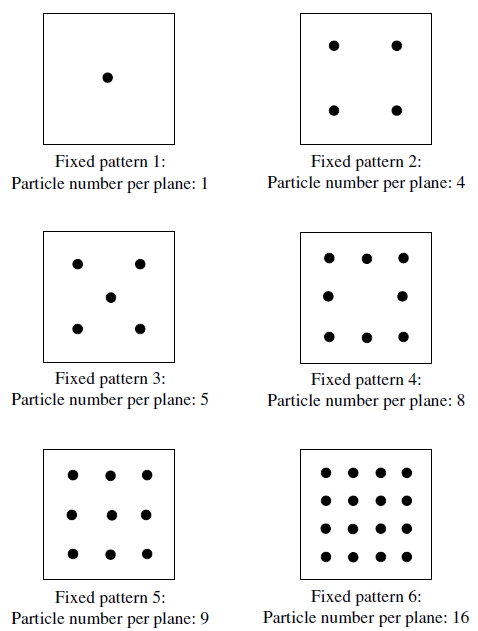ADV: Advection Package Pane |
ADV: Advection Package Pane |
The ADV: Advection Package pane is is on the MODFLOW Packages and Programs dialog box under MT3DMS or MT3D-USGS. It is used to specify data for the ADV package in MT3DMS or MT3D-USGS.
MIXELM specifies the advection solution option. MIXELM = -1, the third-order TVD scheme (ULTIMATE) = 0, the standard finite-difference method with upstream or central-in-space weighting, depending on the value of NADVFD; = 1, the forward-tracking method of characteristics (MOC); = 2, the backward-tracking modified method of characteristics (MMOC); = 3, the hybrid method of characteristics (HMOC) with MOC or MMOC automatically and dynamically selected.
|
ITRACK is a flag indicating which particle-tracking algorithm is selected for the Eulerian-Lagrangian methods. ITRACK = 1, the first-order Euler algorithm is used. = 2, the fourth-order Runge-Kutta algorithm is used; this option is computationally demanding and may be needed only when PERCEL is set greater than one. = 3, the hybrid first- and fourth-order algorithm is used; the Runge-Kutta algorithm is used in sink/source cells and the cells next to sinks/sources while the Euler algorithm is used elsewhere. |
NADVFD is an integer flag indicating which weighting scheme should be used; it is needed only when the advection term is solved. |
PERCEL is the Courant number (i.e., the number of cells, or a fraction of a cell) advection will be allowed in any direction in one transport step. There is no limit on PERCEL, but for accuracy reasons, it is generally not set much greater than one. Note, however, that the PERCEL limit is checked over the entire model grid. Thus, even if PERCEL > 1, advection may not be more than one cell’s length at most model locations. For the third-order TVD scheme, PERCEL is also a stability constraint which must not exceed one and will be automatically reset to one if a value greater than one is specified. |
MXPART is the maximum total number of moving particles allowed and is used only when MIXELM = 1 or 3. |
WD is a concentration weighting factor between 0.5 and 1. It is used for operator splitting in the particle-tracking- based methods. The value of 0.5 is generally adequate. The value of WD may be adjusted to achieve better mass balance. Generally, it can be increased toward 1.0 as advection becomes more dominant. |
DCEPS is a small Relative Cell Concentration Gradient below which advective transport is considered negligible. A value around 10-5 is generally adequate. |
NPL is the number of initial particles per cell to be placed at cells where the Relative Cell Concentration Gradient is less than or equal to DCEPS. Generally, NPL can be set to zero since advection is considered insignificant when the Relative Cell Concentration Gradient is less than or equal to DCEPS. Setting NPL equal to NPH causes a uniform number of particles to be placed in every cell over the entire grid (i.e., the uniform approach). |
NPH is the number of initial particles per cell to be placed at cells where the Relative Cell Concentration Gradient is greater than DCEPS. The selection of NPH depends on the nature of the flow field and also the computer memory limitation. Generally, a smaller number should be used in relatively uniform flow fields and a larger number should be used in relatively nonuniform flow fields. However, values exceeding 16 in two-dimensional simulation or 32 in three-dimensional simulation are rarely necessary. If the random pattern is chosen, NPH particles are randomly distributed within the cell block. If the fixed pattern is chosen, NPH is divided by NPLANE to yield the number of particles to be placed per vertical plane, which is rounded to one of the values shown in Figure 30 of the MT3DMS documentation.  Figure 30. Distribution of initial particles using the fixed pattern (if the fixed pattern is chosen, the number of particles placed per cell (NPL or NPH) is divided by the number of vertical “planes,” or NPLANE, to yield the number of particles to be placed on each vertical plane, which is then rounded to one of the values shown here) |
NPMIN is the minimum number of particles allowed per cell. If the number of particles in a cell at the end of a transport step is fewer than NPMIN, new particles are inserted into that cell to maintain a sufficient number of particles. NPMIN can be set to zero in relatively uniform flow fields and to a number greater than zero in diverging/converging flow fields. Generally, a value between zero and four is adequate. |
NPMAX is the maximum number of particles allowed per cell. If the number of particles in a cell exceeds NPMAX, all particles are removed from that cell and replaced by a new set of particles equal to NPH to maintain mass balance. Generally, NPMAX can be set to approximately two times of NPH. |
NLSINK is a flag indicating whether the random or fixed pattern is selected for initial placement of particles to approximate sink cells in the MMOC scheme. The convention is the same as that for NPLANE. It is generally adequate to set NLSINK equivalent to NPLANE. |
NPSINK is the number of particles used to approximate sink cells in the MMOC scheme. The convention is the same as that for NPH. It is generally adequate to set NPSINK equivalent to NPH. |
DCHMOC is the critical Relative Concentration Gradient for controlling the selective use of either MOC or MMOC in the HMOC solution scheme. The MOC solution is selected at cells where the Relative Concentration Gradient is greater than DCHMOC. The MMOC solution is selected at cells where the Relative Concentration Gradient is less than or equal to DCHMOC. |